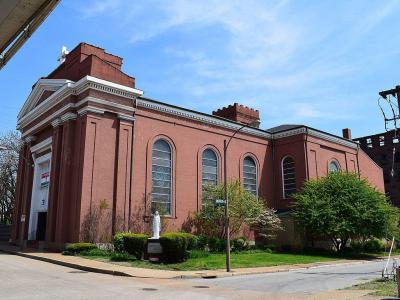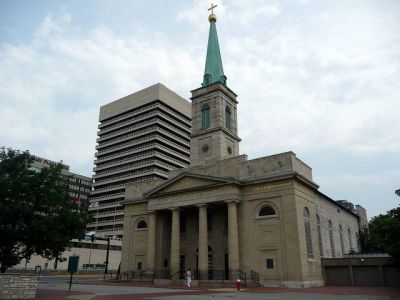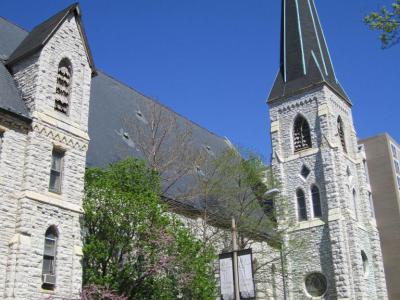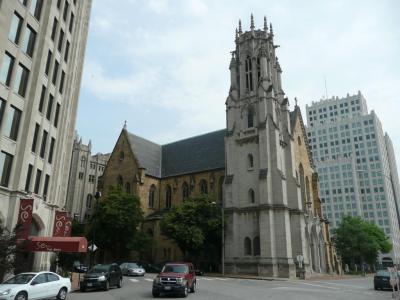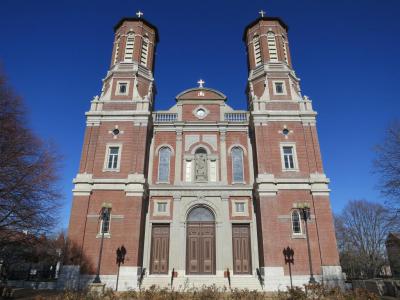Historical Religious Buildings Walking Tour (Self Guided), Saint Louis
Saint Louis, Missouri, is a perfect destination for those with a taste for great architecture, especially if it is associated with an important spiritual value. Indeed, this city features some of the most famous and interesting churches in the USA.
One such landmark is the Saint Mary of Victories Catholic Church. A stunning example of Mannerism architecture, it has been a spiritual hub for the local Catholic community since its construction in the mid-19th century.
The Old Cathedral, formerly known as the Basilica of Saint Louis, King of France, is another iconic religious building. It stands as a testament to the enduring presence of Catholicism in the city. Dating back to the 1830s, the Old Cathedral is a beautiful example of Greek Revival style and has witnessed centuries of worship and cultural change.
Centenary United Methodist Church, a Methodist congregation established in 1869, is a prominent Protestant landmark in Saint Louis. Its Gothic-inspired design and towering spire are visually striking, and it continues to serve as a center of worship and community engagement for the Methodist community.
Christ Church Cathedral, an Episcopal church with roots dating back to the mid-19th century, is another architectural gem. Its Gothic-style appearance and impressive interior make it a captivating place to explore, reflecting the city's diverse religious heritage.
The Shrine of Saint Joseph, with its Romanesque facade, is a testament to the enduring faith of the Catholic community in Saint Louis. This shrine has attracted pilgrims for decades, drawn by its rich history and spiritual significance.
Each of Saint Louis's diverse historical sites offers a glimpse into the city's rich spiritual past. If you're keen on architecture, we encourage you to spare some time to explore these landmarks more closely and thus enrich your understanding of Saint Louis's religious and cultural legacy.
One such landmark is the Saint Mary of Victories Catholic Church. A stunning example of Mannerism architecture, it has been a spiritual hub for the local Catholic community since its construction in the mid-19th century.
The Old Cathedral, formerly known as the Basilica of Saint Louis, King of France, is another iconic religious building. It stands as a testament to the enduring presence of Catholicism in the city. Dating back to the 1830s, the Old Cathedral is a beautiful example of Greek Revival style and has witnessed centuries of worship and cultural change.
Centenary United Methodist Church, a Methodist congregation established in 1869, is a prominent Protestant landmark in Saint Louis. Its Gothic-inspired design and towering spire are visually striking, and it continues to serve as a center of worship and community engagement for the Methodist community.
Christ Church Cathedral, an Episcopal church with roots dating back to the mid-19th century, is another architectural gem. Its Gothic-style appearance and impressive interior make it a captivating place to explore, reflecting the city's diverse religious heritage.
The Shrine of Saint Joseph, with its Romanesque facade, is a testament to the enduring faith of the Catholic community in Saint Louis. This shrine has attracted pilgrims for decades, drawn by its rich history and spiritual significance.
Each of Saint Louis's diverse historical sites offers a glimpse into the city's rich spiritual past. If you're keen on architecture, we encourage you to spare some time to explore these landmarks more closely and thus enrich your understanding of Saint Louis's religious and cultural legacy.
How it works: Download the app "GPSmyCity: Walks in 1K+ Cities" from Apple App Store or Google Play Store to your mobile phone or tablet. The app turns your mobile device into a personal tour guide and its built-in GPS navigation functions guide you from one tour stop to next. The app works offline, so no data plan is needed when traveling abroad.
Historical Religious Buildings Walking Tour Map
Guide Name: Historical Religious Buildings Walking Tour
Guide Location: USA » Saint Louis (See other walking tours in Saint Louis)
Guide Type: Self-guided Walking Tour (Sightseeing)
# of Attractions: 5
Tour Duration: 2 Hour(s)
Travel Distance: 4.4 Km or 2.7 Miles
Author: doris
Sight(s) Featured in This Guide:
Guide Location: USA » Saint Louis (See other walking tours in Saint Louis)
Guide Type: Self-guided Walking Tour (Sightseeing)
# of Attractions: 5
Tour Duration: 2 Hour(s)
Travel Distance: 4.4 Km or 2.7 Miles
Author: doris
Sight(s) Featured in This Guide:
- St. Mary of Victories Catholic Church
- Old Cathedral
- Centenary United Methodist Church
- Christ Church Cathedral
- Shrine of St. Joseph
1) St. Mary of Victories Catholic Church
Saint Mary of Victories Catholic Church is a historic Roman Catholic church situated in downtown Saint Louis. Established in 1843, it is the second Catholic Church to be built in the city and has been designated as a National Register of Historic Places.
Initially, the church was built to serve the spiritual needs of about 500 German immigrant families who had settled in the "Chouteau's Landing" District, a commercial and residential neighborhood in pre-Civil War era Saint Louis. The church played a vital role in providing the German immigrants with a sense of community and identity.
In the 1950s, many of the original families had moved out of the city, and the church saw an influx of refugees from Hungary after World War II and the 1956 Hungarian Uprising. This led to the church being unofficially referred to as the "Hungarian Church" and provided new life to the parish.
The church's architecture is of great significance, designed by George I. Barnett and Franz Saler, two renowned architects, in the early 16th-century Mannerist style. The nave is rectangular and forms a cross with the transept, with the sanctuary at its head. The choir loft is located on the second tier of the two-tier balcony at the rear of the church. The church's ornate wooden-carved organ case and stenciled display pipes are among the oldest in Saint Louis.
The interior of Saint Mary of Victories is equally remarkable, being the first interior in a Saint Louis church whose design was based on liturgical studies. The interior was developed and constructed by Max Schneiderhahn, the first professional church artist in the city. As a German immigrant, Schneiderhahn studied at a German university and two monasteries, bringing the craftsmanship tradition of liturgical art to the Saint Louis area. Schneiderhahn conceived and executed the altars, statuary, steepled baptismal font, communion rail, carvings, and frescoes, along with painting the Stations of the Cross.
Initially, the church was built to serve the spiritual needs of about 500 German immigrant families who had settled in the "Chouteau's Landing" District, a commercial and residential neighborhood in pre-Civil War era Saint Louis. The church played a vital role in providing the German immigrants with a sense of community and identity.
In the 1950s, many of the original families had moved out of the city, and the church saw an influx of refugees from Hungary after World War II and the 1956 Hungarian Uprising. This led to the church being unofficially referred to as the "Hungarian Church" and provided new life to the parish.
The church's architecture is of great significance, designed by George I. Barnett and Franz Saler, two renowned architects, in the early 16th-century Mannerist style. The nave is rectangular and forms a cross with the transept, with the sanctuary at its head. The choir loft is located on the second tier of the two-tier balcony at the rear of the church. The church's ornate wooden-carved organ case and stenciled display pipes are among the oldest in Saint Louis.
The interior of Saint Mary of Victories is equally remarkable, being the first interior in a Saint Louis church whose design was based on liturgical studies. The interior was developed and constructed by Max Schneiderhahn, the first professional church artist in the city. As a German immigrant, Schneiderhahn studied at a German university and two monasteries, bringing the craftsmanship tradition of liturgical art to the Saint Louis area. Schneiderhahn conceived and executed the altars, statuary, steepled baptismal font, communion rail, carvings, and frescoes, along with painting the Stations of the Cross.
2) Old Cathedral
The Basilica of Saint Louis, formerly the Cathedral of Saint Louis, is named for King Louis IX of France, the same monarch for whom the city itself is named. Also known colloquially as the Old Cathedral, it was the first cathedral built west of the Mississippi River, completed in 1834.
Surrounded by the Gateway Arch grounds, the church is technically not part of the Gateway Arch National Park. Fortunately, it was spared demolition due to its historical significance, while other neighboring buildings were destroyed to make way for the Arch.
In recognition of its importance, Pope John XXIII designated it a basilica in 1961—a special designation given to church buildings distinguished for ceremonial purposes.
Built in the Greek Revival style, the basilica is noted for its marble altars, a painting of Saint Louis venerating the Crown of Thorns (a gift from Louis XVIII, King of France and Navarre), and an accurate copy of Diego Velázquez’s Crucifixion, installed in the latter half of the 20th century.
Engraved in gold over the entrance are the Latin words: "In honor of Saint Louis. Dedicated to the one and triune God. A.D. 1834." Hebrew letters, intended to spell out the Tetragrammaton, are also inscribed above the main entrance.
The mosaics in the Cathedral of Saint Louis are a breathtaking showcase of artistry and devotion, covering nearly every inch of the church’s walls, ceilings, and floors. Crafted with vibrant colors and intricate designs, they depict biblical scenes, saints, and symbols of the Catholic faith. Highlights include the detailed representations of Christ, the apostles, and Saint Louis himself, as well as ornamental patterns that draw the eye upward toward the soaring ceilings.
In the basement of the church, visitors can see a number of artifacts associated with the history of the Roman Catholic Archdiocese of Saint Louis, including a bell donated by the governor of the Louisiana Territory in the early 19th century.
Surrounded by the Gateway Arch grounds, the church is technically not part of the Gateway Arch National Park. Fortunately, it was spared demolition due to its historical significance, while other neighboring buildings were destroyed to make way for the Arch.
In recognition of its importance, Pope John XXIII designated it a basilica in 1961—a special designation given to church buildings distinguished for ceremonial purposes.
Built in the Greek Revival style, the basilica is noted for its marble altars, a painting of Saint Louis venerating the Crown of Thorns (a gift from Louis XVIII, King of France and Navarre), and an accurate copy of Diego Velázquez’s Crucifixion, installed in the latter half of the 20th century.
Engraved in gold over the entrance are the Latin words: "In honor of Saint Louis. Dedicated to the one and triune God. A.D. 1834." Hebrew letters, intended to spell out the Tetragrammaton, are also inscribed above the main entrance.
The mosaics in the Cathedral of Saint Louis are a breathtaking showcase of artistry and devotion, covering nearly every inch of the church’s walls, ceilings, and floors. Crafted with vibrant colors and intricate designs, they depict biblical scenes, saints, and symbols of the Catholic faith. Highlights include the detailed representations of Christ, the apostles, and Saint Louis himself, as well as ornamental patterns that draw the eye upward toward the soaring ceilings.
In the basement of the church, visitors can see a number of artifacts associated with the history of the Roman Catholic Archdiocese of Saint Louis, including a bell donated by the governor of the Louisiana Territory in the early 19th century.
3) Centenary United Methodist Church
The Centenary Methodist Episcopal Church is a magnificent example of Gothic Revival architecture located in the city of Saint Louis. The church was built in 1869, making it over 150 years old. It has a rich history and has been recognized for its architectural significance, earning a place on the National Register of Historic Places in 1997.
The church is made up of a two-story limestone building connected to a three-story office/service building. The design of the church was the work of renowned Baltimore architect Thomas Dixon. Local architect Jerome B. Legg supervised its construction. The church features many elements of Gothic Revival style, such as its pointed arches, stained glass windows, and ornate carvings.
In 1924, a three-story addition was built to the west of the original building. Saint Louis architects Mauran, Russell & Crowell designed this addition, which was made of brick and stone. The addition complements the original building and is also built in the Gothic Revival style.
The church is made up of a two-story limestone building connected to a three-story office/service building. The design of the church was the work of renowned Baltimore architect Thomas Dixon. Local architect Jerome B. Legg supervised its construction. The church features many elements of Gothic Revival style, such as its pointed arches, stained glass windows, and ornate carvings.
In 1924, a three-story addition was built to the west of the original building. Saint Louis architects Mauran, Russell & Crowell designed this addition, which was made of brick and stone. The addition complements the original building and is also built in the Gothic Revival style.
4) Christ Church Cathedral
Christ Church Cathedral is an Episcopal cathedral that serves as the central church for the Diocese of Missouri. Built between 1859 and 1867, the cathedral was designed by Leopold Eidlitz, a prominent mid-19th-century American architect, and is one of the few surviving examples of his work. The Gothic Revival style of the structure reflects the city's sense of its importance as the United States expanded westward.
The cathedral's architecture is notable for its expression of early Christian practices and styles, which was influenced by the Oxford Movement originating in England. It was designated a National Historic Landmark in 1994 for its architectural significance. The cathedral is located in downtown Saint Louis, at the southeast corner of Thirteenth and Locust Streets.
The church is made primarily of Illinois sandstone, and its roof is made of purple and green slate. The cruciform structure features a tower projecting from the northern facade at the northwest corner, which houses a baptistry with a font made of Italian marble. In addition to the main body of the church, a smaller sandstone chapel was added in 1893-1895.
From 1910 to 1912, a tower and porch made of Indiana limestone were added to the cathedral, and a chime of three steel bells was dedicated in 1912. The bells were cast by the Bochumer Verein Foundry in 1904, with the bourdon bell weighing 5,732 pounds, making it the largest bell in Missouri.
The cathedral's architecture is notable for its expression of early Christian practices and styles, which was influenced by the Oxford Movement originating in England. It was designated a National Historic Landmark in 1994 for its architectural significance. The cathedral is located in downtown Saint Louis, at the southeast corner of Thirteenth and Locust Streets.
The church is made primarily of Illinois sandstone, and its roof is made of purple and green slate. The cruciform structure features a tower projecting from the northern facade at the northwest corner, which houses a baptistry with a font made of Italian marble. In addition to the main body of the church, a smaller sandstone chapel was added in 1893-1895.
From 1910 to 1912, a tower and porch made of Indiana limestone were added to the cathedral, and a chime of three steel bells was dedicated in 1912. The bells were cast by the Bochumer Verein Foundry in 1904, with the bourdon bell weighing 5,732 pounds, making it the largest bell in Missouri.
5) Shrine of St. Joseph
The Shrine of Saint Joseph in Saint Louis is a historic Catholic church that began in 1843 when the Jesuits founded the parish to serve the local community of German immigrants. The church has a rich history and is the site of the only authenticated miracle in the Midwestern United States.
Mrs. Ann Biddle, a generous and wealthy widow, donated the land for the church, and the cornerstone for the new church was blessed by Bishop Kenrick on April 14, 1844. The church building, a modest structure that faced west towards 11th Street, was completed in 1846 and dedicated on the first Sunday in August of that year, with Father James Van de Velde officiating.
The Saint Joseph parish was a very active community and, in 1862, a large parish school was built nearby to care for the many children of the area. The School Sisters of Notre Dame staffed the school, providing a quality education for the children of the parish.
Today, the Shrine of Saint Joseph remains an important religious and cultural center in Saint Louis. Although it is not a parish in the ordinary sense, the Friends of the Shrine of Saint Joseph, a 501(c)(3) non-profit organization, operate and maintain the church. Masses are celebrated each Sunday and on First Fridays of each month, offering a spiritual refuge to those seeking solace and inspiration.
Mrs. Ann Biddle, a generous and wealthy widow, donated the land for the church, and the cornerstone for the new church was blessed by Bishop Kenrick on April 14, 1844. The church building, a modest structure that faced west towards 11th Street, was completed in 1846 and dedicated on the first Sunday in August of that year, with Father James Van de Velde officiating.
The Saint Joseph parish was a very active community and, in 1862, a large parish school was built nearby to care for the many children of the area. The School Sisters of Notre Dame staffed the school, providing a quality education for the children of the parish.
Today, the Shrine of Saint Joseph remains an important religious and cultural center in Saint Louis. Although it is not a parish in the ordinary sense, the Friends of the Shrine of Saint Joseph, a 501(c)(3) non-profit organization, operate and maintain the church. Masses are celebrated each Sunday and on First Fridays of each month, offering a spiritual refuge to those seeking solace and inspiration.
Walking Tours in Saint Louis, Missouri
Create Your Own Walk in Saint Louis
Creating your own self-guided walk in Saint Louis is easy and fun. Choose the city attractions that you want to see and a walk route map will be created just for you. You can even set your hotel as the start point of the walk.
Saint Louis Downtown Walking Tour
Missouri’s main city, Saint Louis, is a vibrant metropolis, alive with culture, music, and art. But before the French fur traders ever showed up, this land was home to the Mississippian tribes, who had already built thriving communities along the river.
Fast forward to 1764: two French fur traders plant their flag and name the place after King Louis IX of France. Ironically, that very year,... view more
Tour Duration: 2 Hour(s)
Travel Distance: 3.5 Km or 2.2 Miles
Fast forward to 1764: two French fur traders plant their flag and name the place after King Louis IX of France. Ironically, that very year,... view more
Tour Duration: 2 Hour(s)
Travel Distance: 3.5 Km or 2.2 Miles
Forest Park Walking Tour
Forest Park, a massive urban park in Saint Louis, offers a wide range of attractions and activities for visitors of all ages. Renowned for its multiple entertaining and educational facilities, such as museums, zoo, and green areas, it is often and quite deservedly regarded as one of the city's crown jewels – an ideal location for a great time out! Let's see what you can find on the... view more
Tour Duration: 3 Hour(s)
Travel Distance: 5.9 Km or 3.7 Miles
Tour Duration: 3 Hour(s)
Travel Distance: 5.9 Km or 3.7 Miles
The Most Popular Cities
/ view all



